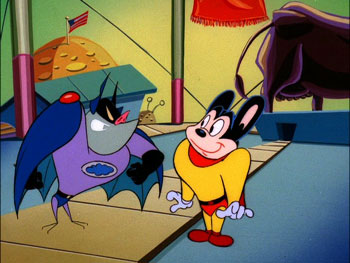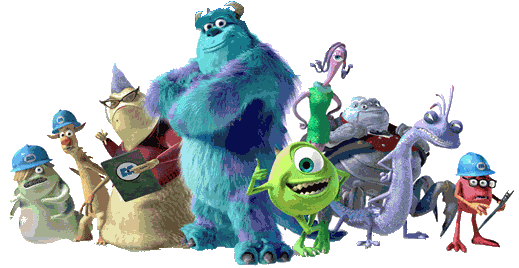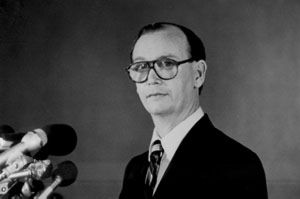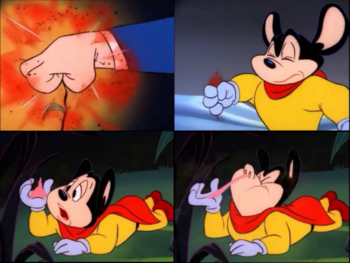“Nobody had tried to make a funny cartoon on Saturday morning for, I think, almost twenty years. What was the last one, probably George of the Jungle? Jay Ward was the last guy who actually tried telling jokes on a kid’s cartoon. And then nothing…”
–Writer Jim Reardon
Jim Reardon should know. He became a writer/producer on The Simpsons for 14 years, a show which has become the longest running entertainment program on American television, and later was nominated for an Oscar as co-writer for the Pixar movie WALL-E. But a quarter of a century ago, just before The Simpsons started out as short segments on The Tracey Ullman Show, Reardon had recently graduated from California Institute of the Arts animation classes. He and a bunch of other fresh-faced newbies in the television world were about to turn animation on its ear, led by one old radical and one almost forgotten cartoon hero. The radical was Ralph Bakshi, and the show they produced together was Mighty Mouse: The New Adventures.
–
On Saturday mornings in 1987, CBS aired a re-imagining of Mighty Mouse, an old Terrytoons character from the late 1940’s who’d become a popular television feature in the ’50’s and early ’60’s. A young artist named Ralph Bakshi had worked on many of those old Terrytoon productions, before becoming an animation upstart with animated movies like Wizards, The Lord of the Rings, and Fritz the Cat (which was the first animated movie to earn an “adults only” X-rating). While many were surprised that Bakshi and his animation studio were involved in producing a show for Saturday morning television aimed at youngsters, Bakshi believed that animation was for everyone, and that making purely “educational” programming meant making “boring” programming.
After meetings with ABC and NBC, and pitching original ideas for animated programs with no success, he went to CBS with an idea for a revamped version of Mighty Mouse, made for both kids and adults, and the network gave him a modest budget with the hope that something new might be conceived.
They had no idea what was coming.
“What do you remember about (the original) Mighty Mouse? ‘Here I come to save the day’ and he flies in. That’s all they remember. So we had a lot of leeway to play in.”
–Jim Reardon
While the original theme song of “Here I Come to Save the Day” is something of a cultural memory, the character of Mighty Mouse is basically a ripoff of Superman, just done as a mouse. He battled cats (who were naturally evil from a mouse point of view) and a few deranged rodents along the way. But Bakshi and company decided that Mighty Mouse: The New Adventures was simply the vehicle they were going to use to tell entertaining and occasionally cutting social satire, using the character as a framework to host their own stories. Their sense of parody and desire to break the (then) conventional mode of Saturday morning cartoons led to a tremendous amount of creativity.
Characters would break the “fourth wall”, speaking directly to the camera (and the audience at home). Backgrounds were stylized, and heroes and villains were designed as way-over-the-top, exactly as satire demanded. Episodes spoofed everything from other staid Saturday morning shows to libertarian novelist Ayn Rand’s The Fountainhead (a book which, not surprisingly, very few usual Saturday morning viewers were familiar with). Bakshi’s edict was not to toe the line, but for the animators to have fun, and to make something THEY would enjoy, with no thought given to network desires or supposed audience marketing reports. So that’s what they did.
“I don’t think you could afford to put all the names in the same room now that came out of that first season. Ralph basically was too cheap to hire real television writers. He didn’t want to pay them, and so…. But to give him credit, he also felt he was just going to get sad, tired, same old television Saturday morning thinking. And he thought ‘I want fresh blood, and I also can get it cheap if I go to students coming right out of school’ and he was right!”
–Writer Andrew Stanton
This started a revolution in animated television, and many of those young men and women involved in The New Adventures went on to become involved in some of the most successful shows and movies in animation history. Working on Mighty Mouse: The New Adventures were people like Jim Reardon and Andrew Stanton, who went on to write and animate for Pixar Studios and their productions of Toy Story, Monsters, Inc., Finding Nemo, and WALL-E.
–
A developing producer for Bakshi Studios was John Kricfalusi, who went on to create The Ren and Stimpy Show, and was involved in many other shows for Nickelodeon and Cartoon Network. And character designer Bruce Timm has been instrumental in the looks of everything from Tiny Toon Adventures to the numerous award-winning updates of DC comic properties on television, like Batman: The Animated Adventures and Justice League. Modern television animation would not be remotely the same without the talented people Ralph Bakshi first gathered together to work on Mighty Mouse: The New Adventures, and television changed significantly because of them.
“I let the guys perform. And you know what? They perform “above”…. They can’t believe that they’re free, and they perform well. That’s the major Bakshi secret. You hire talented guys, and tell ’em not what to do. A lot of studios hire talented guys and tell them how to do it. It’s mindless. It boggles the imagination. It’s like hiring Norman Rockwell and telling him how to draw!”
–Ralph Bakshi
This group of people (and there are more, just not space here to mention them all) led a revolution in animation, both on television and later in motion pictures. They may have been young, but they had found a place where they could create with few boundaries, and the developed skills that changed animation. Many of the leadership of Pixar Studios first worked together on The New Adventures, and their new and unusual styles became something others in the medium couldn’t wait to try. Within the next year television saw radical departures from the norm of animation like Bettlejuice, and the release of Who Framed Roger Rabbit in theatres, combining live action and cartoons. Mighty Mouse: The New Adventures was a critical success (both in and out of the industry), and the series was on the verge of becoming a popular one as well.
Of course, with change always comes a bit of controversy. And when a Saturday morning show is being led by someone who once notoriously released an X-rated picture, animated or not, then obviously there’s a target that someone else is going to find a reason to shoot at, worthy or not. Enter the Reverend Donald Wildmon and the American Family Association.
Started one evening in the mid-’70’s because Reverend Wildmon decided that nothing on television could be watched by families with young children, the American Family Association led boycotts against select shows (in addition to books and magazines) which they believed promoted ideas that children should be protected against. These shows included popular (yet controversial) shows like All in the Family (and its portrayal of race relations through Archie Bunker) and Three’s Company (which engaged in sexual innuendo and had a lead character who “pretended” to be gay). Rev. Wildmon and the AFA also protested against radio shock DJ Howard Stern and Madonna’s music video for the song “Like a Virgin”. And yet, it is hard to understand the firestorm of allegations started by this organization over a particular cartoon. Rev. Wildmon and the AFA singled out one scene in a segment of Mighty Mouse: The New Adventures entitled The Littlest Tramp, saying it promoted drug use. John Kricfalusi recaps the story from there:
“The flower-sniffing controversy. I don’t even know why this was a controversy. If you actually watch the story and see the context, there’s a little flower girl, (writer) Tom Minton’s “littlest tramp”, and she stands on the street corner with flowers, trying to sell them to people. There’s this mean guy based on Kirk Douglas, and at one point he crushes her flower. Mighty Mouse shows up just afterwards, and because he’s nice to her, she gives him the only thing she has, and it’s this crushed flower, and he puts it in his pocket. And later, Mighty Mouse thinks back to the flower girl, and says, ‘You know, I knew somebody like that.’ and smells it, like you would smell a flower. And it goes up his nose.”
One of Rev. Wildmon’s followers down in Mississippi saw the segment, brought it to his attention, and soon there were cries for a boycott and loud demands that CBS fire “that pornographer” Bakshi (even though Fritz the Cat got an X-rating for language and not nudity). OBVIOUSLY, they were promoting the sniffing of cocaine to children!!!
Well, of course they weren’t. The only thing obvious about the previous sentence was the sarcasm of the capital letters. Even a show as occasionally subversive and radical as The New Adventures wasn’t trying to turn America’s youth into drug-crazed zombies, and Mighty Mouse himself had no effects from the incident other than memories of his association with the girl (which was the whole point). Still, thanks to the shrill rallying cry of Rev. Wildmon and the AFA (who claimed large numbers, but never proved them), there were news stories in major newspapers, and even a mention in Time magazine. But ultimately the noise brought MORE attention to the series, not less, and the entire escapade shows how useless and idiotic an out-of-context controversy can be, and how a “tempest in a teapot” can be made out of something innocent.
“And the weird thing is, there’s plenty of stuff in the cartoon that you COULD go after. There’s all kinds of stuff that they could have jumped all over. Instead, they just made something up.”
–John Kricfalusi
In this case, the flower-sniffing really was the most innocent thing in the story. Although it’s a parody of Hans Christian Anderson’s The Little Match Girl, the Kirk Douglas-inspired human villain ends up getting spanked over the knee of Mighty Mouse, and ends up repenting and marrying the mouse-girl… just before they both drive off and their limo explodes in an atomic blast, complete with mushroom cloud. Corporal punishment, inter-species marriage, and even the explosion of a nuclear bomb passed without comment, but don’t you DARE show anyone smelling a crushed flower to remind them of someone else’s kindness!!!
The initial season of Mighty Mouse: The New Adventures ran for 13 half-hour episodes, and a second six episodes followed the next year. While many of the segments were outright parodies, some barely featured Mighty Mouse at all, while others revived previous Terrytoon characters like Deputy Dawg and nemesis Oil Can Harry. In one segment, Mighty Mouse must help a group of aged super-powered heroes — collectively known as the Mighty Heroes — as they attempt a comeback (but unbeknownst to them, Mighty Mouse is doing all the work, and they’re just succeeding due to his unseen efforts). The Mighty Heroes piece was a tribute to Bakshi himself, as he had created a 1960’s Saturday morning show early in his television career featuring those characters in their prime (and is fondly remembered by some of us, including me, who was a faithful watcher as a youth). Even with the progressive ideas of The New Adventures, there was still room for some nostalgia… especially flavored with satire and snark.
Mighty Mouse: The New Adventures is available on DVD, with a great behind-the-scenes documentary called “Breaking the Mold” (from which many of the quotes in this article were taken). There is a more detailed account of the “flower-sniffing” controversy on the show’s Wikipedia site, including comments from Bakshi about his strong feelings against drugs in general, and against the misinterpretation of this particular piece of work specifically. And while Mighty Mouse was briefly resurrected yet again for a commercial in 2001, it was hastily yanked off the air after the destruction of 9/11, which was similar in vague respects to the events on the ad.
“Ralph once said a film or a cartoon is only good if it’s a reaction against something else. And Mighty Mouse was a reaction against a lot of mediocrity.”
–Tom Minton
The late 1980’s were a time of change, both in the world at large and in the industry of television. The world was becoming a smaller place, with governments finding their direction after the Cold War had ended, and both uncertainty and promise awaited. Television was changing both in content and technology, with new, independent stations, and the rise of cable networks by the score allowing for different ideas to be prominent. Mighty Mouse: The New Adventures led the way in this department, with young minds and fresh ideas, and although they (by their own admission) made some mistakes, the radical Bakshi and his crew of upstarts re-created an old icon for a new generation.
The same thing was going on everywhere, in every medium, with old ideas being reinvented into new thoughts and new ways of seeing the world. Television could act as the eyes bringing us that view, and by allowing Jim Reardon, Andrew Stanton, John Kricfalusi, and all the others a voice, they found something all of us can learn from. You could hear that voice, even now: “Here I Come, to Save the Day!” They were a Mighty Mouse (and his mighty creators) that roared, and they continue to do so to this day….
–
Vital Stats
19 aired episodes — none unaired — available on DVD
CBS Network
First aired episode: November 22, 1987
Final aired episode: October 22, 1988
Aired on Friday @ 8/7 Central? Hardly. Although some of the humor that went over kids heads might have been more understandable there, it was still smarter than some of the stuff in prime time. No wonder it didn’t last.
Comments and suggestions appreciated, as always.
–Tim R.






